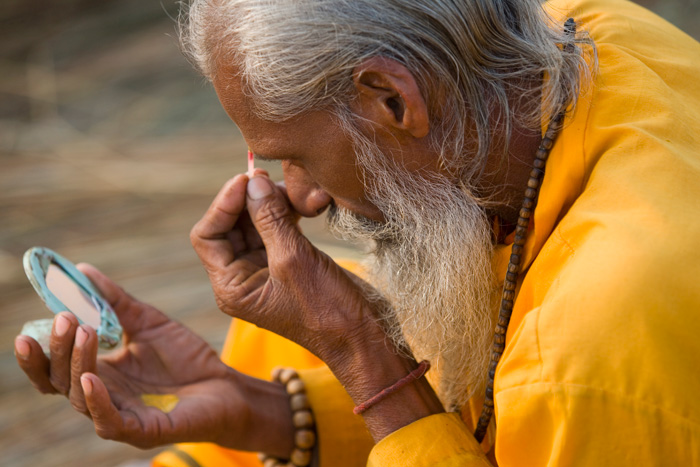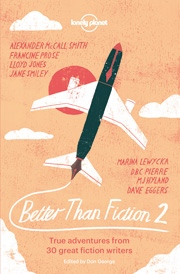Swami Sand Castle

Note: Lonely Planet has just published Better Than Fiction 2, a compelling collection of true travel stories written by acclaimed fiction writers. We are pleased to excerpt the story below, by award-winning author Francine Prose, about an unforgettable experience in India. Prose is the author of more than twenty books of fiction and nonfiction. Her most recent is a novel, Lovers at the Chameleon Club, Paris 1932. She is a Distinguished Visiting Writer at Bard College.
Once, over lunch, I told an editor at a glossy travel magazine that I wanted to write a piece about the experience of not understanding a place, of being intrigued—but bewildered—the whole time I was there and leaving with no clear idea of what that place had been about. I’d said I’d noticed that the essays in his magazine were always written by travelers who seemed to know everything about their destinations long before they got there, or by writers who had a charming local friend who explained the region’s many appealing customs and attractions, preferably over dinner at a villa, and provided introductions to nearby Michelin-starred chefs and gourmet-food providers. Was I the only person who had ever gone somewhere, been confused, and felt that I’d never figured anything out? From across his plate of micro-greens, the editor stared at me as if I’d suggested writing a piece about the nicest places on the planet in which to catch bubonic plague.
So here is a story about one of those mysteries of travel that has remained in my mind as a succession of somewhat dreamlike events, and a series of questions.
For years I couldn’t remember the name of the village. I’d search for it on maps, but all I knew was that it was somewhere on the coast of the Arabian Sea between Cochin and Trivandrum, in the southern Indian state of Kerala. Then one morning, not long ago, I woke up and thought: Varkala! I googled the town, which turns out to have developed (surprise!) dozens of luxury and middle-class resorts along its gorgeous beach. But nothing remotely like that existed when Howie (now my husband, then my boyfriend) and I arrived in the winter of 1978.
Varkala
Varkala was beautiful. We could see the palm trees and the clean white beach from the narrow road that ran through the peaceful little town. We assumed there would be somewhere to stay the night. After a day at the beach, we would continue on our trip across South India, through which I had traveled a few years before; I’d loved it and longed to return.
The bus left us in beautiful Varkala, where, as it turned out, there were no hotels. But a helpful man at the bus stop told us that a young fellow, very respectable, actually his nephew, was building some houses on the beach. One of these houses was nearly finished, and for a small fee the landlord-builder would probably let us stay there.
The house was easy to find, and the landlord spoke perfect English. He said we could stay on an air mattress in the mostly finished house, which had working plumbing, and he would bring us breakfast—some yogurt and fruit—and vegetarian dinner, all included in the price. The fee, in fact, was amazingly small. We decided to stay for two nights.
That first afternoon at the beach we met some fishermen and their wives. The women gave me betel to chew, and tried to teach me how to spit, with something like panache, the red saliva that betel produces and that tourists in India sometimes mistake for blood, on the sidewalk. They laughed delightedly when red slime dribbled off my lower lip. The men tried to persuade Howie to go ocean fishing on what was basically a carved-out log, and when I begged him not to, they thought that was hilarious too. Anyway, they were probably joking. Testing us, I imagine.
For the rest of that day, and all the next, we sat on the beach near our house and watched a sadhu—a wandering holy man—perform a ceremony that was in more or less constant progress and consisted of various sorts of work on the beach, not far from where we sat. Because some of that work involved raking the sand and patting and piling it up into ceremonial circles and lingam-like sculptural shapes, Howie and I began referring to him as Swami Sand Castle.
Sadhu
The first thing that needs to be said about Swami Sand Castle is that he was extraordinarily handsome and that all his movements were assured and graceful, and fascinating to watch. He was tall and thin, and though he seemed to be in his early thirties—not all that much older than we were—his long hair had already turned silver. His eyes were so shockingly blue that we could see them from the polite and comfortable distance at which we sat. He was bare-chested, his skin was golden brown, and he wore the long wrapped white skirt the Indians call a dhoti, which gave him a Hindu Jesus effect. I liked the idea of a holy man who could have been a rock star back home.
For a long time he didn’t notice us, or didn’t appear to. And then he did. He nodded once and acknowledged us, and we smiled back. After that his manner changed a little and became, intermittently, a performance. He knew we were there, but he had work to do. Our watching gave the experience an ever so slightly voyeuristic edge, and—given how striking he was, and how young and in love and attractive we were then—an ever so slightly erotic aspect.
In addition to raking and patting the sand, he ministered to a steady trickle of people, men and women, old and young, families and solitary pilgrims, who came to him to receive a blessing, a dab of paint on their foreheads, and a packet wrapped in a leaf. They gave him money, then took the packets down the beach and threw them into the sea. When the stream of people slowed he would kneel and either make things out of sand or prepare more packets, small scoops of rice and spices wrapped in banana leaves.
That evening our landlord explained that it was a puja, a ceremony. Pilgrims traveled to buy a packet of food from the sadhu, food that the dead were known to like. Then they threw the packet into the sea, where the dead would somehow find it—and be fed.
By the second day we had developed a sort of relationship with the sadhu. When we got to the beach—on which, it seemed, he lived—he waved to us, and we waved back. Were we disturbing him? We didn’t think so. Even if he didn’t speak English, we reasoned, he could make it clear if he wanted us to leave.
Swami Sand Castle didn’t speak English. Late that afternoon, he walked off the job and came over to us, and motioned for us to follow him. He pointed toward the town. He tilted an imaginary tea cup toward his lips. He said, “Chai.”
A Cup of Chai
A cup of tea seemed simple enough. We’d go along and see where this went. We trailed Swami Sand Castle up the beach into the center of town and into a little hut. Maybe fifteen men sat on the floor or squatted at tiny tables drinking cups of the sweet milk tea that was boiling in a caldron watched over by a sweating kid on a high stool up front. Every one of them looked up and stared at us, curious but not unfriendly. In pantomime, the sadhu made it clear that we would be buying him tea. He indicated the others: a round for the boys. Sure. This would still cost us next to nothing.
This is where my memory stops. Did we drink our tea in silence? Did we try to communicate in a simple language that involved pointing to ourselves and saying words that neither side understood, and nodding as if we did? Howie remembers that everyone smiled a lot. I remember Swami Sand Castle thanking us, pressing his palms together, and saying goodbye. We went back to our house, and I suppose he went back to the beach, to wherever he came from.
That evening, after dinner, Howie and I both got violently ill, first one of us, then the other; we took turns. When the landlord came to collect the tiffins, the metal containers in which he’d brought us dinner, he heard Howie retching in the bathroom. He asked me what was wrong, and though I felt sick myself, I told him the story of our day, all about the sadhu and the tea.
Cluck cluck. Our landlord said we’d made a grave mistake. This sadhu was from a very low caste, not a harijan, an Untouchable, but almost. The tea house he took us to was patronized by people of the same and similar castes. It was very dirty, very unclean there. No wonder we got sick! I remember feeling the particular embarrassment of travelers who have made a stupid tourist mistake.
Thanks to paregoric, an opium syrup one could get more easily those days, and which has a miraculously calming effect on the worst intestinal illness, we were able to get on the bus the next day and get out of town and go on to Trivandrum.
Do I understand what happened in Varkala? I have more questions than answers. Now that all the resorts have been built, are pilgrims still coming for packets of food to throw into the sea? Who was Swami Sand Castle? Where did he come from and what did he believe? What was he doing with the sand and what did he think about it? Who did he think we were? Was he as curious about us as we were about him? Who were the people who came to him for food to feed their dead? Why did I tell our landlord about the sadhu and the tea? Why were we so ready to believe our landlord, that the cup of the tea from the low caste café was what made us sick? Couldn’t we just as likely have caught something from the yogurt and fruit he brought or the vegetable curry dinner?
Even if we went back to Varkala, I would never find out. But I don’t mind. I don’t need to know the answer, and indeed I prefer that so much of what happened there remains unclear. For what is travel if not a confrontation with the mysterious, and why should we assume—or desire—that every mystery will be solved?
# # # # #
Reproduced with permission from Better Than Fiction 2, 1st edition, edited by Don George, with contributions by M.J. Hyland, Francine Prose, et al. Copyright © 2015 (Lonely Planet).

To learn more about options for group and custom trips to India, give GeoEx a call at 888-570-7108.

